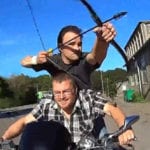 Music
Music  Music
Music  History
History 10 Less Than Jolly Events That Occurred on December 25
 Weird Stuff
Weird Stuff 10 Funny Ways That Researchers Overthink Christmas
 Politics
Politics 10 Political Scandals That Sent Crowds Into the Streets
 Weird Stuff
Weird Stuff Ten Bizarre Facts About The Doge Meme
 Our World
Our World 10 Ways Your Christmas Tree Is More Lit Than You Think
 Movies and TV
Movies and TV The 10 Coolest Stars to Set Sail on The Love Boat
 History
History 10 Things You Didn’t Know About the American National Anthem
 Technology
Technology Top 10 Everyday Tech Buzzwords That Hide a Darker Past
 Humans
Humans 10 Everyday Human Behaviors That Are Actually Survival Instincts
 Music
Music 10 Surprising Origin Stories of Your Favorite Holiday Songs
 History
History 10 Less Than Jolly Events That Occurred on December 25
 Weird Stuff
Weird Stuff 10 Funny Ways That Researchers Overthink Christmas
Who's Behind Listverse?

Jamie Frater
Head Editor
Jamie founded Listverse due to an insatiable desire to share fascinating, obscure, and bizarre facts. He has been a guest speaker on numerous national radio and television stations and is a five time published author.
More About Us Politics
Politics 10 Political Scandals That Sent Crowds Into the Streets
 Weird Stuff
Weird Stuff Ten Bizarre Facts About The Doge Meme
 Our World
Our World 10 Ways Your Christmas Tree Is More Lit Than You Think
 Movies and TV
Movies and TV The 10 Coolest Stars to Set Sail on The Love Boat
 History
History 10 Things You Didn’t Know About the American National Anthem
 Technology
Technology Top 10 Everyday Tech Buzzwords That Hide a Darker Past
 Humans
Humans 10 Everyday Human Behaviors That Are Actually Survival Instincts
10 Things People Get Wrong about Weapons
Most of us tend to think we have a pretty good handle on how weapons work, even if we have never drawn one. After all, we live in a rather warlike world, where movies, video games, and all other popular media are full of heroes and villains fighting with every manner of weapon imaginable. However, while the flashy style of movies is fun to watch and video games are really fun to play, they don’t often show us an appropriately accurate picture of how weapons work now or how they worked historically.
So here’s a list of 10 things people often get wrong about weapons.
Related: 10 Crazy Ancient Weapons You’ve Never Heard Of
10 War Hammers: They’re Not Like in Video Games
In video games, war hammers are usually long staves with a huge hammerhead the size of a human skull and often a lot larger at the end. They are usually weapons designed for bludgeoning and mostly do various forms of impact damage in most games. This has led to a pervasively common belief that a weapon like this existed, but it simply isn’t so. People are not nails, and no one ever made a giant hammer with a hammerhead the size of a human skull so they could crush it flat like an egg.
Warhammers did exist, though; they were just a bit different from what some people think. Sometimes they had spear points at the top. But more commonly, they simply had a bludgeoning end for stunning the opponent and a sharp end for getting through joints in armor and piercing the enemy’s defenses.
They became popular in the 15th and 16th centuries when plate mail became more common and were often held by higher-ranking cavalry as a sign of rank. The length of the weapon would have been similar to a sword and needed to be much smaller than video game hammers in order to do its important armor-piercing work.[1]
9 Gun Silencers Are Louder Than Movies Portray
Movies have led us to believe that if you want to carry out an assassination quietly, you just use a silencer. You pop that accessory on just like a video game, sneak up behind your target, and with a barely heard little “snip” of sound, they are done. Then, you can fade into the night without being noticed. This belief is carried by many people who haven’t used guns much, but those who have know just how loud guns really are and tend to call them something different.
Those in the know call them suppressors because they really only suppress sound, not actually silence it. For example, the best shotgun silencer drops the sound from 155 to 132 decibels which can still be compared to a jackhammer. And the truth is that for this reason, most people who use this accessory are actually doing so to protect their ears, not try to sneak an attack on someone.
However, this misconception goes all the way back to 1930 when the government made it hard to get them, thinking they would help gangs hide their activities. Today, gun activists have had success so far in repealing the stricter laws that required a one-month waiting period and background check in 12 states, arguing suppressors are only for ear protection.[2]
8 Killing with A Knife Is Harder Than It Sounds
In video games and movies, killing someone with a knife is hilariously easy. In a movie, they usually just stab their victim in the stomach, to which they die almost immediately but painfully and helplessly. Or they are quickly knifed in the back, to which they let out a painful grunt and fall down dead. In video games, you can sneak behind someone, and with a quick slash across their neck, it is all over with no mess—the second part being even more fantasy than the first.
However, in reality, it is way harder to kill someone with a knife than it sounds. Knives are pretty small weapons, and most aren’t even that sharp or that powerful. You are going to have to have a very good knife and go for vital organs. But this presents more problems, as hitting vital organs on a moving target with a tiny weapon is not exactly easy, and taking someone out with something that small actually requires a pretty serious amount of strength as well.
To those who are skeptical of the difficulty, ask the man who survived being stabbed nine times with a knife. Or the woman who took 32 cuts from her crazy boyfriend and is now dating the paramedic who saved he. She also recovered so well that she now works as a nurse.[3]
7 You Can’t Run from an Explosion and Surf the Shockwave
In action movies, one of the favorite tropes is to have the hero or heroes running from an explosion as it chases them down a hallway. At the last second, as the fireball chases them, they throw themselves over some kind of explosion-proof boundary, and the flames whoosh harmlessly over their heads. In some cases, the explosion shockwave actually hits them in midair, and they surf it over the lip of some obstacle and then land safely to avoid the flame. It makes for great TV, and it looks really, really cool, but in reality, it is completely impossible.
The problem is that explosions are both really fast and really, really powerful as well. Once you are in the radius of a nearby explosion, and it is already going off, it is too late. It doesn’t matter if you were already running or even almost around a corner. It is going to fry you up and may not even leave much left of you to find, depending on the type of explosion. Also, despite how cool it looks, shock-wave surfing is also not going to help you. If the shockwave hits you, you are already dead.[4]
6 Ball and Chain Mace Not Used in Serious Capacity
In movies and video games, the ball and chain mace is a common enough weapon to see. Many times in movies, you will see this weapon wielded by a fearsome champion who almost beats the hero, only being stopped just in time by some clever move. The idea that they would be wielded by champions makes sense as it is a weapon that would certainly require great skill to use effectively without hurting yourself.
However, the truth is that the ball and chain mace was likely never seriously used in combat at all. There are pieces in museums, but many experts think they were just prototypes or ceremonial weapons and not actually used for combat. Now, this doesn’t mean that the weapon was never used at all. Still, most weapons used in any serious capacity have archeological evidence to back them up or texts and pictures to show their common use. The ball and chain mace simply doesn’t have any evidence of this kind, and only a few stylized pieces remain.[5]
5 The Video Game Flamethrower Is Not Really That Effective
In video games, the flamethrower is basically a super weapon. You just spin it across a group of enemies, and the next thing you know, they are flailing on the floor, helpless to attack you as they die. In many games, this feature makes it the most effective melee weapon imaginable, and it never seems to run out of ammo.
While this is a fun fantasy in games, the truth in real life is that the flamethrower was never meant to be a combat weapon of any sort, nor was it really meant to be a typical anti-personnel weapon as such. Its purpose was more to clear trenches than anything else when trench warfare was first established and was turning things into a slog.
Men carrying the flamethrowers experienced extreme danger because they were heavy, low ammo, priority targets, and were even made up as giant weapons batteries or put on tanks. It was also a very powerfully psychological weapon, as the fear of being burned to death bothers everyone. For this reason, there was shock and outrage at its initial usage.[6]
4 Clanging Sword Edges Together Tended to Break Them
In action movies, swords are regularly clanged together as the hero and villain fight in a desperate battle to save or end the day. The sound makes the scene really cool, and the constant parries give us an enjoyable sense of action in the scene. It is fun for us, and we forget about reality and just enjoy the battle raging around us. Most people never question this unless they start to learn about how swords work—which is when it all falls apart.
And speaking of falling apart, that is what will happen if your sword starts clanging against another sword. You will quickly bend it, chip it and even break it before you even know what is happening. It simply isn’t worth the risk and is usually avoided at all costs during a sword fight. Instead, sword users would often dodge the blow sent at them by their opponent while slashing or hacking back at them.
When they did actually clang blades, they usually deliberately used the flat of their blades to avoid damaging the edges. They also often made good use of their shields, blocking the sword with the shield and striking back with their blade, as the two devices were meant for.[7]
3 Two Guns at Same Time Only Wastes Ammo
In The Matrix, Boondock Saints, and many other popular movies, they make it look really cool to shoot two handguns at the same time. The hero is seen as being super powerful for killing twice as many bad guys at once, and no one ever questions the practice in the movie. Many people who have seen movies like this have come to believe that this would actually be practical, but it is anything but.
The problem is essentially the way our vision works. Even if you think you can move your eyes really, really fast, you really can only focus on one target at one time. This means that if you are going to go ahead and use two guns, there are a few different things that can happen, and none of them are effective.
You could just use both guns on the same target, but this is an aim decrease when you could have just used two hands to hold one gun. You could try to shoot both in different directions without looking and hope you hit something. Or you could try to look rapidly back and forth while firing wildly with a one-handed grip that gives you terrible aim. As for reloading, it is impossible to reload two guns at once, which is why The Matrix has them drop their guns when they run dry.[8]
2 Police Baton’s Roots in Ancient Martial Arts
Many people know little about the modern police baton and think of it as little more than a club and another part of a police officer’s growing arsenal. Some assume it simply harkens back to the days when police went around with billy clubs instead of guns. While there is some truth to this, it has evolved to be something more than that over time. As police forces looked for more effective weapons, they decided to add a handle to the baton to make it more like a tonfa. This makes it more capable as a defensive weapon and for holding assailants, as opposed to just for attacking.
The idea goes back to Okinawan martial arts, usually karate, that turned a handle for a grist mill into a weapon when the invading Japanese authorities banned them from having weapons. Interestingly, due to its complexity as a weapon and the fact you usually don’t train with it until you are a black belt, some expert police trainers think its use as a police tool should be abolished. Part of the issue is that while the police baton has no sharp edges to lower lethality, it is still a weapon that you can easily hurt yourself with if you use it wrong.[9]
1 Being a Sniper in Real Life Actually Requires Math
In movies, a sniper duel is usually two people who can see each other through their scopes, trying to trick the other person into coming out of cover long enough for them to take them out. While this may have once been the case before modern technology, today, sniping is quite a bit different from that. It is even further from video games, where a lone sniper with no partner just scopes for headshot after headshot from some camping spot and suffers virtually no recoil.
However, in real life, it requires a lot more math than you might imagine and is a lot less up close and personal. Most snipers are firing from at least 1,968 feet (600 meters) away to hide the sound of their attack. This means you have to understand how gravity and wind will affect your shot over a long distance.
To avoid counter-sniping and assist with calculations, snipers will also usually have a partner. As for video games, even with a partner, headshots are impractical. Snipers are trained to go for center mass near the chest and neck or near the hips and pelvis. The reason is if you try to hit the head and you get a close miss, the target will just go to the ground.[10]








